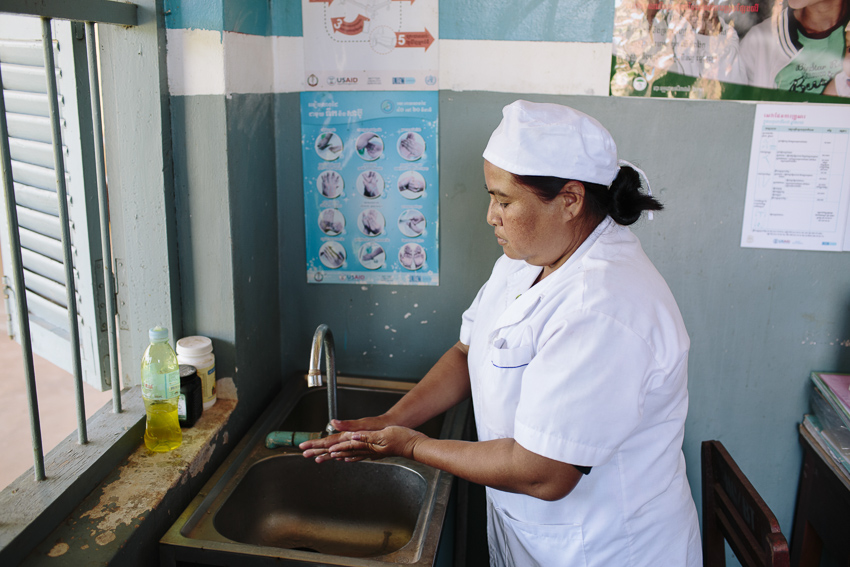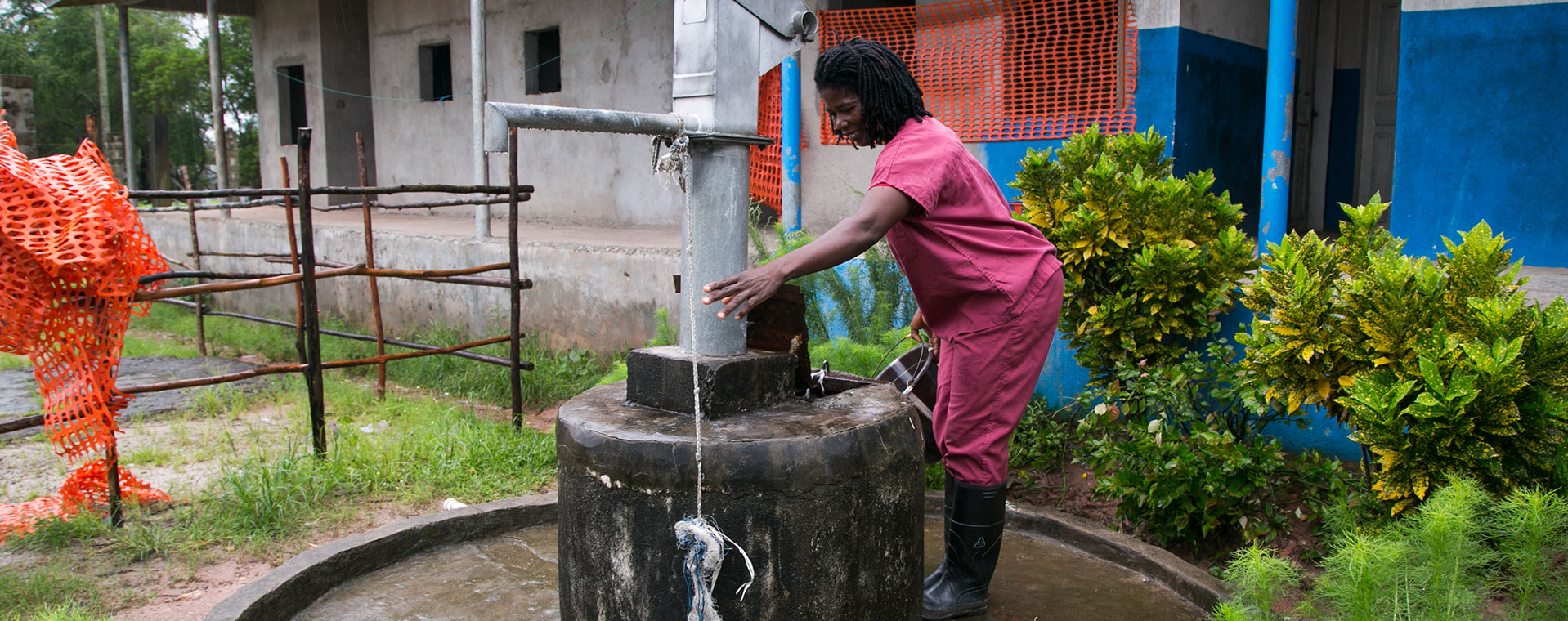
Cambodia: Research to address hygiene behaviours around birth as part of quality improvement
STORIES |
Key messages
- Routine situational analyses are important to support continued reform and ensure WASH remains a priority among policy-makers.
- WASH standards and indicators must align across all health policies and processes.
- Leadership and coaching are required to support sustained and quality routine risk-based assessments and improvements.
- Understanding determinants and drivers of behaviour is critical to inform long-term behaviour change: education alone is not sufficient.
Context and triggers
Cambodia has a long history of health reform and ambition to support quality health care services for all. From the 1990s to 2000s, health reform saw the extension of basic health care services across the country and health financing reforms that reduced financial barriers to accessing care. These health reforms have resulted in greater utilization of services with almost all women delivering in health care facilities (89.0% in 2014). As service uptake has increased and financial barriers (e.g. out-of-pocket costs) are easing, attention has shifted to improving the quality of health care services. The National Health Strategic Plan 3 (HSP3) 2016–2020 clearly outlines a plan for improving the quality of health care in Cambodian public health care facilities. WASH is recognized within quality, with targets set for water and sanitation in all health care facilities.
A joint government–donor pooled funding project, the Health Equity and Quality Improvement Programme (H-EQIP), has been implemented under the HSP2. H-EQIP includes three main components: (i) strengthening health service delivery through service delivery grants; (ii) improving financial protection and equity through health equity funds (HEFs); and (iii) ensuring sustainable and responsive health systems. While HEFs mainly seek to increase health service utilization by the poor, the redesigned service delivery grants focus on improving the quality of health service delivery. WASH in health care facilities is embedded within the national quality monitoring mechanism linked to service delivery grants, accounting for 30% of the infrastructure and management score within these quarterly assessments. These quality assessments are rolled out nationally in all public health care facilities. Incentives for improvements result from higher quality scores being rewarded as part of performance-based financing schemes.
Conduct situation analysis and assessment
In 2015 and 2016, two studies were conducted to assess the situation of WASH in health care facilities. The first, a scoping review led by the National Institute of Public Health (NIPH), focused on: (i) policies and planning, including standards and coverage targets related to WASH in health care facilities (6); (ii) monitoring and evaluation mechanisms, tools and data, in particular the routine facility data collected through the HMIS; and (iii) key actors involved in or working on WASH in health care facilities and their related role and responsibilities. The review provided a number of policy recommendations, including developing national WASH indicators to be incorporated into the HSP3, development of national standard tools for assessment of WASH in health care facilities and to conduct a national assessment of WASH in health care facilities.
Responding to the recommendation made by the 2015 situation analysis, a first assessment of WASH in 117 health care facilities (101 health centres and 16 referral hospitals) in five provinces using the newly developed national standard tools was conducted in late 2016 by the NIPH in collaboration with the MoH. The assessment provided useful information and evidence for improving WASH in health care facilities in Cambodia in the five study provinces, and led to further improvement of the national standard tools for WASH in health care facilities. An additional situation analysis was conducted by the NIPH and WHO in 2018 to further understand how WASH was addressed within the national quality mechanism. WASH indicators are now being amended to better align with national guidelines on WASH in health care facilities.
Establish national standards and accountability mechanisms
Following the inclusion of WASH within the HSP3, it was recognized that there was an absence of WASH guidelines to complement the national guidelines on infection prevention and control and health care waste management. A set of guidelines were developed and endorsed in late 2018 (7). The guidelines covering health centres and hospitals are now being rolled out nationally through dissemination and capacity-building activities. WASH is also recognized within the minimum package of activities (MPA), a set of guidelines designed to provide operational guidance to health centres, enabling health centres to effectively and efficiently provide safe services.
As the WASH guidelines were endorsed after the roll out of the national quality monitoring mechanism, efforts are underway to ensure better alignment of the guidelines with the quality indicators and to explore how additional coaching and risk-based approaches such as WASH FIT can support accountability and adherence to the guidelines.
Contextualization and evaluation of WASH FIT
WHO, UNICEF and WaterAid, along with respective provincial health departments, have tested WASH FIT across several provinces in Cambodia at both the health centre and hospital levels. While WASH FIT has not yet been rolled out at scale, the following is known: Firstly, the WASH FIT assessment needs to be contextualized to national guidelines and level of care and aligned with quality indicators. Secondly, facilities are already improving quality through the H-EQIP programme, and as this is directly linked to financing, training support and accountability, it is a strong motivator to improve WASH services: synergy between approaches is important. Lastly, leadership from facility managers is also essential: to do this, they require training and coaching.
Greater collaboration is underway with disabled people’s organizations to ensure WASH facilities are accessible and usable by all. Tools are available to undertake WASH facility audits to assess usability alongside processes to better engage diverse users in design processes for facilities. Standard designs for accessible infrastructure have been developed and are being implemented in selected health centres. Further work is underway to develop similar audits and designs for hospital-level services. Moreover, the accessible latrine and bathroom infrastructure questions are being integrated in the upcoming standard assessment tool for the national competition programme for model public services.
Conduct operational research and share learning
As WASH services have been improving through H-EQIP mechanisms, attention has been drawn to addressing hygiene behaviours to improve infection prevention, with a focus on labour, delivery and the early postnatal period. With leadership and technical input from the MoH, the London School of Hygiene and Tropical Medicine and support from the Australian Government’s Water for Women Fund, the NIPH and WaterAid are conducting research to understand determinants of hand hygiene behaviour during these critical times. This research project – Changing Hygiene Around Maternal Priorities (CHAMP) (8) – follows the innovative behaviour-centred design approach to intervention development and evaluation. Following a period of in-depth formative research, structured observation and participatory intervention development, the resulting multimodal intervention targets the context-specific determinant of hand hygiene during childbirth and postnatal care while complementing national IPC standards and policies through environmental nudges, motivational drivers and supportive supervision models. Results from the intervention pilot are expected in early 2021.
